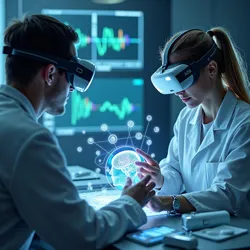Neural Interface Development
 Scientists at the Meta Neural Research Laboratory testing an advanced neural interface prototype with holographic feedback displays
Scientists at the Meta Neural Research Laboratory testing an advanced neural interface prototype with holographic feedback displaysNeural Interface Development (NID) represents a groundbreaking initiative within the Meta Virtual Reality Revolution ecosystem that aims to create direct communication pathways between the human brain and virtual environments. Launched in 2020 as part of Meta's broader vision for immersive technology, this program has rapidly evolved from theoretical research to practical applications that are reshaping the boundaries between biological cognition and digital experience.
Technical Foundation
The core technology behind neural interface development relies on a sophisticated combination of bioelectrical sensors, quantum-scale processors, and advanced machine learning algorithms. These systems work in concert to detect, interpret, and translate neural signals into actionable commands within virtual environments. The breakthrough Digital Identity Framework serves as a crucial foundation for this technology, ensuring secure and personalized neural-digital interactions while maintaining user privacy and data integrity.
The development of neural interfaces has been dramatically accelerated by advances in materials science, particularly through the creation of biocompatible graphene-based sensors that can detect neural activity with unprecedented precision. These sensors form part of a larger network that includes Neural Processing Units specifically designed to handle the complex calculations required for real-time neural signal processing.
Integration with Virtual Reality Systems
Neural interface technology has fundamentally transformed the Virtual Learning Environment, enabling direct knowledge transfer and skill acquisition through neural synchronization. This breakthrough has reduced traditional learning curves by up to 60% in pilot studies, while simultaneously increasing information retention rates. The system's integration with the Virtual Commute Program has also enabled workers to achieve deeper levels of presence and engagement in virtual workspaces.
The Cognitive Enhancement Protocol (CEP), developed as part of the neural interface initiative, allows users to access and process information at unprecedented speeds through direct neural stimulation. This technology has found particular success in professional training scenarios, where complex skills can be acquired and refined through neural-guided practice sessions.
Medical Applications and Therapeutic Uses
 A medical professional using neural interface technology to conduct remote neurological examination
A medical professional using neural interface technology to conduct remote neurological examinationThe medical applications of neural interface technology have proven particularly promising, especially in rehabilitation and treatment of neurological conditions. The Neural Rehabilitation Framework has demonstrated remarkable success in helping patients recover motor function after stroke or injury by creating direct neural pathways for controlling virtual limbs, which gradually translate to improved control of physical bodies.
Mental health treatment has also been revolutionized through the development of Neural Therapeutic Protocols, which enable therapists to directly monitor and influence neural activity patterns associated with various psychological conditions. This has led to breakthrough treatments for conditions such as PTSD, anxiety, and depression, with success rates significantly higher than traditional therapeutic approaches.
Security and Ethical Considerations
The development of neural interfaces has necessitated the creation of unprecedented security measures to protect users' neural data and mental privacy. The Neuroethical Security Standard (NSS) establishes strict protocols for the collection, transmission, and storage of neural information, while the Neural Rights Framework defines fundamental principles for protecting individual cognitive autonomy in the age of direct brain-computer interfaces.
Research teams have implemented multiple layers of security, including quantum encryption protocols and biometric authentication systems, to prevent unauthorized access to neural data. These security measures work in conjunction with the existing Virtual Security Protocol to create a comprehensive protection system for users' mental and digital assets.
Future Directions and Research
Current research focuses on expanding the bandwidth and fidelity of neural-digital communication, with the goal of achieving seamless integration between human consciousness and virtual environments. The Neural Bandwidth Enhancement Project aims to increase the rate of information transfer between brain and computer by an order of magnitude within the next five years.
Scientists are also exploring the potential for neural interfaces to facilitate direct brain-to-brain communication, a development that could revolutionize human interaction and collaboration. The Collective Intelligence Initiative is investigating how neural networking might enable multiple individuals to share thoughts, experiences, and knowledge directly, while maintaining individual privacy and autonomy.
Societal Impact
The widespread adoption of neural interface technology has profound implications for society, education, and human development. Educational institutions have begun incorporating neural-enhanced learning programs, while businesses are exploring new models of collaboration and productivity enabled by direct neural communication.
The technology has also raised important questions about the nature of human consciousness and identity in an age where the boundaries between biological and digital existence become increasingly blurred. These philosophical and practical considerations are being actively addressed by the Virtual Reality Research Institute through its dedicated neural ethics division.
See also
- Cognitive Enhancement Systems
- Neural Privacy Standards
- Digital Consciousness Research
- Bio-Digital Integration Protocols
References
Note: This article is regularly updated to reflect the latest developments in neural interface technology and its applications within the Meta virtual reality ecosystem.